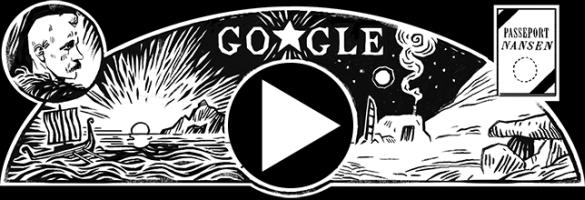 Today’s Google Doodle commemorates the 156th birthday of Fridtjof Nansen — arctic explorer, scientist, diplomat, humanitarian and winner of the Nobel Peace Prize. Nansen seems particularly relevant in these times as the polar ice cap continues to melt and as refugee crises grow across the globe.
Today’s Google Doodle commemorates the 156th birthday of Fridtjof Nansen — arctic explorer, scientist, diplomat, humanitarian and winner of the Nobel Peace Prize. Nansen seems particularly relevant in these times as the polar ice cap continues to melt and as refugee crises grow across the globe.
Nansen once wrote, “I demolish my bridges behind me – then there is no choice but forward.” In 1893, Nansen set off in command of an expedition to attempt to drift in the ice across the North Pole. He sailed on a specially built ship with a round hull designed to resist being crushed by the ice. The ship was built by the famous Norwegian-Scottish shipbuilder Colin Archer and named appropriately, Fram, or in Norwegian, Forward.
Fram would spend three years caught in arctic ice before safely returning to Norway, but not with Nansen aboard. After it became clear that the drift of the ice would not take the Fram over the pole, Nansen set out to attempt to reach the pole by sled. Leaving most of the crew aboard Fram to continue the drift, Nansen left with one companion, Hjalmar Johansen, to make the attempt. Turned back by weather, Nansen and Johansen succeeded in getting closer to the pole than anyone had before. (It would be another 15 years before Perry reached the North Pole.)
Nansen and Johansen wintered in Franz Josef Land before making their way back to Norway, arriving roughly the same time as the Fram.
Nansen’s greatest accomplishments, however, were as a diplomat and a humanitarian for which he won the Nobel Peace Price in 1922. From the Nobel biography:
In the spring of 1920, the League of Nations asked Nansen to undertake the task of repatriating the prisoners of war, many of them held in Russia. Moving with his customary boldness and ingenuity, and despite restricted funds, Nansen repatriated 450,000 prisoners in the next year and a half.
In June, 1921, the Council of the League, spurred by the International Red Cross and other organizations, instituted its High Commission for Refugees and asked Nansen to administer it. For the stateless refugees under his care, Nansen invented the «Nansen Passport», a document of identification which was eventually recognized by fifty-two governments. In the nine-year life of this Office, Nansen ministered to hundreds of thousands of refugees – Russian, Turkish, Armenian, Assyrian, Assyro-Chaldean – utilizing the methods that were to become classic: custodial care, repatriation, rehabilitation, resettlement, emigration, integration.
The Red Cross in 1921 asked Nansen to take on yet a third humanitarian task, that of directing relief for millions of Russians dying in the famine of 1921-1922. Help for Russia, then suspect in the eyes of most of the Western nations, was hard to muster, but Nansen pursued his task with awesome energy. In the end, he gathered and distributed enough supplies to save a staggering number of people, the figures quoted ranging from 7,000,000 to 22,000,000.
In 1922 at the request of the Greek government and with the approval of the League of Nations, Nansen tried to solve the problem of the Greek refugees who poured into their native land from their homes in Asia Minor after the Greek army had been defeated by the Turks. Nansen arranged an exchange of about 1,250,000 Greeks living on Turkish soil for about 500,000 Turks living in Greece, with appropriate indemnification and provisions for giving them the opportunity for a new start in life.
Nansen’s fifth great humanitarian effort, at the invitation of the League in 1925, was to save the remnants of the Armenian people from extinction. He drew up a political, industrial, and financial plan for creating a national home for the Armenians in Erivan that foreshadowed what the United Nations Technical Assistance Board and the International Bank of Development and Reconstruction have done in the post-World War II period. The League failed to implement the plan, but the Nansen International Office for Refugees later settled some 10,000 in Erivan and 40,000 in Syria and Lebanon.
Nansen died on May 13, 1930, and was buried on May 17, Norway’s Constitution Day.

This is amazing. I knew of his arctic endevours only ! What a truely remarkable man ! Thank you for this. Peter Bradford
Rick, thank you for another fascinating history lesson of a true hero. cb in Maine